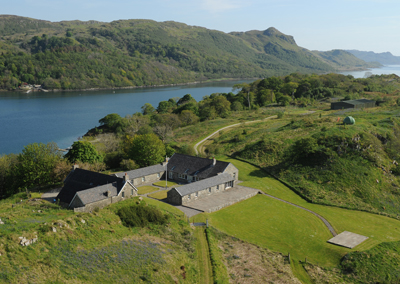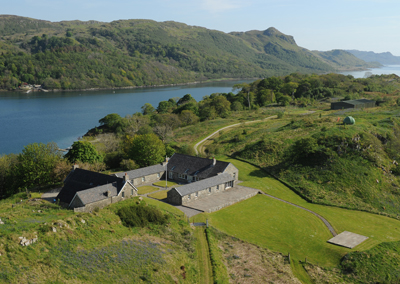Best of 2012: Scottish Riviera property
White sandy beaches, a jaw-dropping coastline and first-class seafood - welcome to the west coast of Scotland


Many of us have been left wondering what happened to our summer this year. For once, it seems, we may have an answer: it holidayed on the west coast of Scotland. The Hebrides have been one of the sunniest places in the country in 2012, and it's not a one-off. The Gulf Stream that gives Cornwall its balmier climate also hits Scotland at its westernmost points, and, just as in Cornwall, you often see palm trees in people's gardens. Of course, the weather isn't always idyllic, but when the sun does appear, many agree that there's nowhere better to be.
This part of Scotland is all about the water, whether it's a sea loch, an inland loch, the coast or on the islands. ‘There's more demand for Argyll than any other area because of the magical combination of quality of life and value for money,' says Andrew Perratt from Savills in Glasgow (0141-222 5874). Ran Morgan of Knight Frank (0131- 222 9600) is also a convert.
‘There's more coastline in Argyllshire than there is in the whole of France,' he says, ‘and the views out to the islands are tremendous. You'd have to go really quite far to see scenery like it-most likely to New Zealand.' According to Strutt & Parker's Andrew Rettie (0131-226 2500), the area is sometimes even known as ‘Fjordland', such is its similarity to the dramatic views found in Norway.
But there's more to Scotland's west coast than Argyll. The entire rugged, undulating coastline running from Dunoon in the south to the Kyle of Lochalsh and Skye in the north is pocketed with spotless white, sandy coves and endless rocky inlets and outcrops that are irresistible to sailors, who can find some of the most challenging sailing anywhere in Britain-witness the rate at which the wind rushes down the Sound of Mull. But even if you're not confident handling a boat, just puttering out at sunset to leave a lobster pot under a rock overnight is a wonderful way to (attempt to) catch your lunch. And scallops or mussels cooked fresh on the beach taste better than they do in any Michelin-starred restaurant. For those less inclined to don a wetsuit, there are always fishermen willing to sell their catch from boats, and restaurants have greatly improved in recent years. Previously, Scotland had the raw materials for firstclasscooking, but few chefs who knew what to do with them. However, there are now countless top-notch places to eat along the coast, from Ee-Usk fish restaurant in Oban to the Three Chimneys on Skye. The wildlife is equally thrilling: whales, dolphins, seals and puffin colonies are all common sights, and other attractions include stalking and fabulous hill-walking, according to John Coleman of Smiths Gore (0131-344 0888).

* Country Life Summer Subscriptions Sale - Save £55 a year!
Those who haven't visited are invriably unprepared for the scenery-it's magnetic for those who are keen on dramatic terrain. Many visitors come on holiday, or to friends' houses, and, inevitably, some get so attached that they buy a property, either for holidays or as a permanent home. Some are even looking for a second or third holiday property, according to Mr Rettie. This part of Scotland tends to attract not just locals but also English buyers looking for a change in pace of life, as well as homesick expatriates. International buyers tend to be on the hunt for prestigious coastal country houses or private islands, and some are looking all over the country: Mr Morgan remembers a buyer who was talking to a number of different Knight Frank coastal offices on the hunt for a waterside property anywhere in the UK. Eventually, he chose a house on the west coast, and cost may have been a factor, as prices are comparatively cheap.
‘There's an enormous disparity in values between here and the South-East,' explains Iain Robb from Strutt & Parker in Glasgow (0141-225 3880). Mr Morgan estimates buyers get 25% off what they'd pay for a waterfront property in Cornwall or Devon. Waterside cottages and old farmhouses with a couple of acres start at about £400,000, and a large country property with more than 20 acres on the water could fetch £1.5 million. Savills recently sold a small baronial house on Bute with four bedrooms and two acres, plus its own private beach for just £475,000-‘I could have sold that house 20 times over,' Mr Perratt says, wistfully. And James Carnegy from CKD Galbraith sold Kilbrandon House, a large country property near Oban in outstanding private grounds overlooking its own natural harbour for well over its guide of £750,000 this year.
Sign up for the Country Life Newsletter
Exquisite houses, the beauty of Nature, and how to get the most from your life, straight to your inbox.
Buyers are split into two groups: those who require accessible properties and those who can manage a longer journey time to Glasgow or the sleeper at Fort William. Businessmen buy in and around Oban and Ardfern, along Loch Fyne (all 40 miles of it) or Dunoon, all of which have excellent transport links. Those opting for solitude on the mainland head to Mallaig, Ardnamurchan, Knoydart or Wester Ross, where the fishing is exceptional. Offshore, popular islands include Arran, Islay, Mull and Skye. There's an enduring perception that you're cut off if you're based on the islands, but, in fact, many residents run successful businesses thanks to fast broadband speeds, and Tesco Direct will deliver anywhere in the Hebrides for a small surcharge. Mobile-phone signal is as good as it is in any part of the country where it's patchy, ferries are regular and roads are quick. And then there's the peace and quiet, which many aficionados say are priceless.
* Follow Country Life Property on Twitter
-
 'The watch is Head Boy of men’s accessorising': Ginnie Chadwyck-Healey and Tom Chamberlin's Summer Season style secrets
'The watch is Head Boy of men’s accessorising': Ginnie Chadwyck-Healey and Tom Chamberlin's Summer Season style secretsWhen it comes to dressing for the Season, accessories will transform an outfit. Ginnie Chadwyck-Healey and Tom Chamberlin, both stylish summer-party veterans, offer some sage advice.
By Country Life Published
-
 Lewis Hamilton, Claude Monet and the Four Horsemen of the Apocalypse: Country Life Quiz of the Day, April 29, 2025
Lewis Hamilton, Claude Monet and the Four Horsemen of the Apocalypse: Country Life Quiz of the Day, April 29, 2025Tuesday's Quiz of the Day looks back at Lewis Hamilton's first win and ponders on the meaning of greige.
By Toby Keel Published
